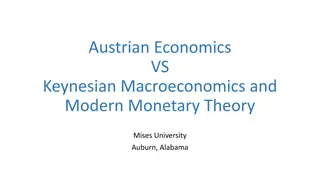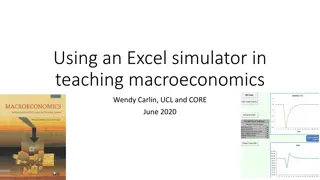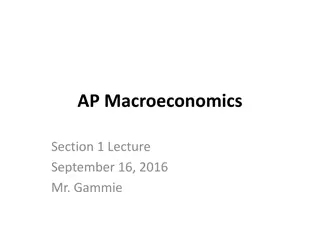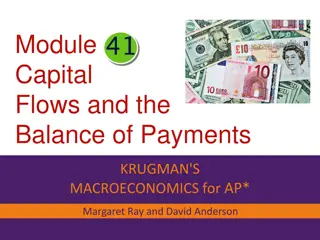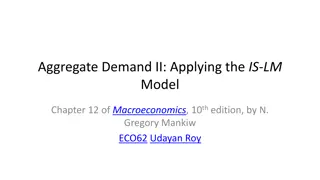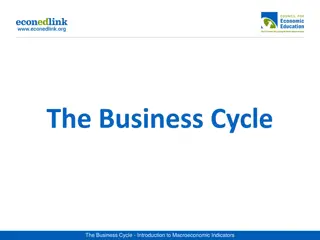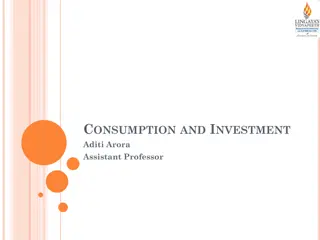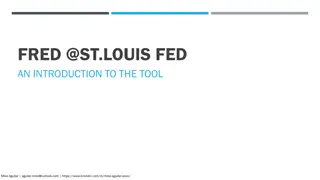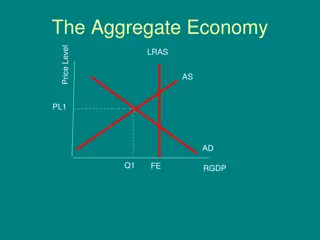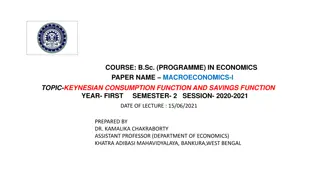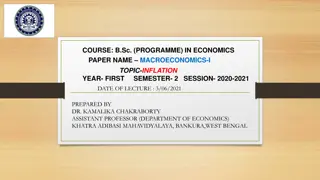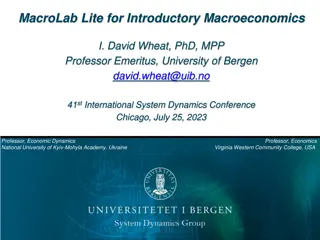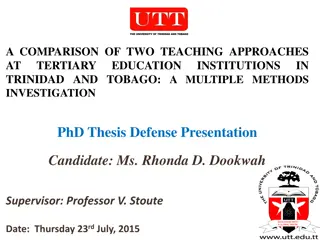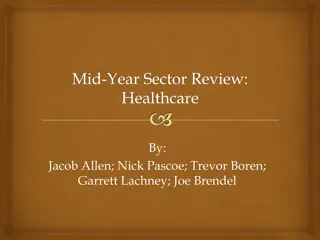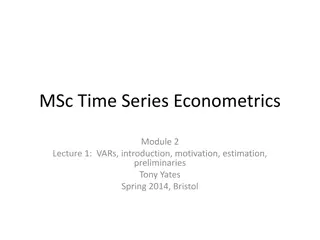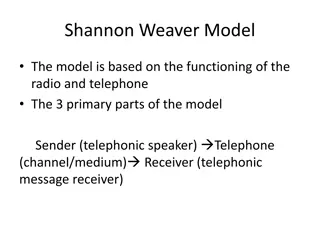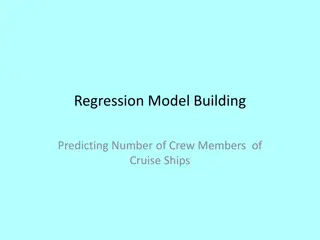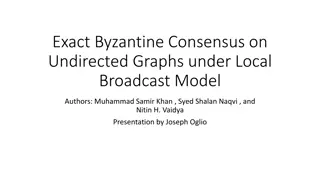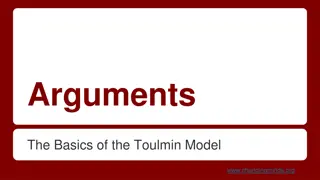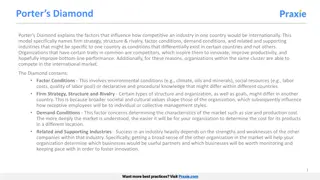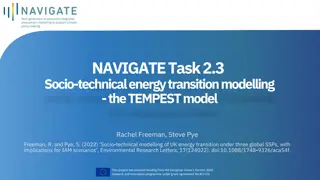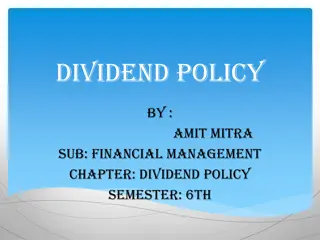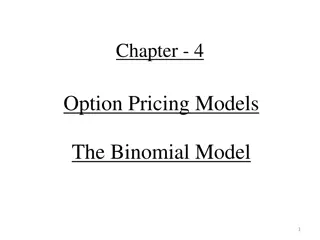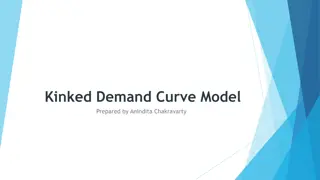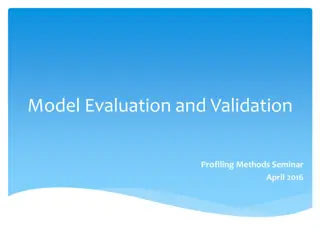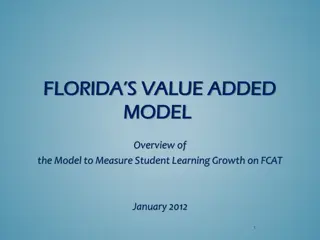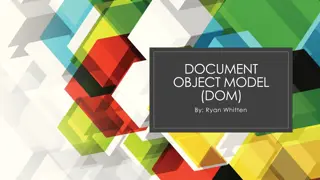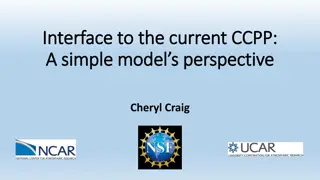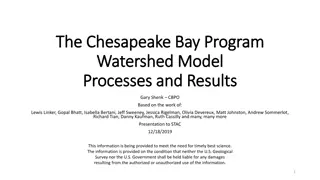Understanding the IS-LM Model in Macroeconomics
This content delves into the IS-LM theory of static short-run macroeconomics, focusing on the goods market in the short run. It discusses the difference between real and nominal variables, recaps long-run macroeconomics, and explores the Keynesian Cross theory to understand short-run equilibrium. Exogenous and endogenous variables are highlighted to depict the complexity and simplicity of economic theories involved.
Download Presentation

Please find below an Image/Link to download the presentation.
The content on the website is provided AS IS for your information and personal use only. It may not be sold, licensed, or shared on other websites without obtaining consent from the author. Download presentation by click this link. If you encounter any issues during the download, it is possible that the publisher has removed the file from their server.
E N D
Presentation Transcript
Aggregate Demand I: Building the IS-LM Model Chapter 11 of Macroeconomics, 10thedition, by N. Gregory Mankiw ECO62 Udayan Roy
Static Short-Run Macroeconomics In this chapter, I will describe the IS-LM theory of static short- run macroeconomics
Recap of Chapters 3 and 5 Long-Run Macroeconomics (Chs. 3, 5) ? = ? ?0.3?0.7 ? = ?0+ ?? (? ?) ? = ? + ? + ? ? = ?0 ?? ? Let s first look at the real variables (Ch 3) ? = ? ?0.3?0.7 ? = ?0+ ?? (? ?) ? = ? + ? + ? ? = ?0 ?? ? Real variables Goods Markets Ch. 3 ? = ?? ?? ? = ? + ? ? =?0 Nominal variables Assets Markets Ch. 5 ? ? ? Variables in red font are endogenous. Variables in black font are exogenous.
Recap: Equations of Chapter 3 ? = ? ?0.3?0.7 ? = ?0+ ?? (? ?) ? = ? + ? + ? ? = ?0 ?? ? Chapter 3 was about the long run. Now we are discussing the short run. In the short run, the available capital and labor may not be fully utilized. Therefore, the first equation is not applicable in the short run. Exogenous variables in black Endogenous variables in red The other 3 equations continue to apply.
Equations from Chapter 3 that are still applicable in the short run Note that there are four unknowns (endogenous variables) and only three equations. ? = ?0+ ?? (? ?) ? = ? + ? + ? ? = ?0 ?? ? We saw in Chapter 1 that to make the theory solvable, the number of unknowns must equal the number of equations. So, we must find ways to make the number of unknowns equal to the number of equations. Exogenous variables in black Endogenous variables in red One approach is the IS-LM theory later in this chapter. We begin with an easier approach called the Keynesian Cross theory.
The simplest theory of short-run equilibrium in the goods market THE KEYNESIAN CROSS
The Keynesian Cross Theory The Keynesian Cross theory assumes that business investment spending is exogenous (that is, inexplicable, like the weather). You may think of this as assuming that the real interest rate, r, is exogenous and that therefore ? = ?0 ?? ? is also exogenous. The ? = ?0 ?? ? equation is now unnecessary. ? = ?0+ ?? (? ?) ? = ? + ? + ? ? = ?0 ?? ? Exogenous variables in black Endogenous variables in red
The Keynesian Cross Theory Now, you have two endogenous variables, output (Y) and consumption spending (C), in two equations. So, the Keynesian Cross theory can be solved! See the next slide. ? = ?0+ ?? (? ?) ? = ? + ? + ? Exogenous variables in black Endogenous variables in red
Keynesian Cross Theory Our first equation makes the supply of goods and services (Y) equal to the demand for goods and services (C + I + G). ? = ? + ? + ? = + + + ( ) Y C C Y T I G o y The textbook refers to the demand for goods and services as planned expenditure: PE = C + I + G. = + + + Y C C = Y C T I G o y y So, the goods market equilibrium equation can also be written as Y = PE. + + Y C Y C = C T I + G + y o y 1 ( ) C Y C C + T I G y o y + C C 1 T I G Note that every variable on the right hand-side of the last equation is exogenous. So, this equation is a solution equation. It tells us everything we can say about Y in the Keynesian Cross model. o y = Y C y
Short-Run GDP: predictions + + C C 1 T I G Predictions Grid Q: Can you look at the solution equation for short-run output and see why it algebraically implies the predictions in the predictions grid? o y = Y Y C Co T + y I + Recall from Ch. 3 that: The first row of the predictions grid lists endogenous variables (unknowns) In this case, Y is the only endogenous variable The first column lists exogenous variables (knowns) In this case, C0, T, I and G are the exogenous variables Each cell shows the kind of effect that the corresponding exogenous variable has on the corresponding endogenous variable G + Important: Note that there is absolutely no reason why this short-run equilibrium GDP has to be equal to the long-run equilibrium GDP ( ?) that we studied in Chapter 3. In other words, the Keynesian Cross model is able to explain why recessions (Y < ?) and booms (Y > ?) happen.
The Keynesian Cross Equation Let s rewrite the Keynesian Cross solution for short-run GDP: + + C C 1 T I G C 1 o y y = = + + C ( ) Y I G T o 1 1 C C C y y y
The Spending Multiplier ?? 1 ? = 1 ?? ??+ ? + ? Note that if Co + I + G increases by $1.00, then Y increases by $1/(1 Cy). We saw in Ch. 3 that Cy is the marginal propensity to consume or MPC. So, 1/(1 Cy) may be written as 1/(1 MPC). This is called the Keynesian Cross spending multiplier. 1 ?? ?
The Spending Multiplier ?? 1 ? = 1 ?? ??+ ? + ? As the marginal propensity to consume is a positive fraction (0 < MPC < 1), 1 MPC is also a positive fraction. Therefore, 1/(1 MPC) > 1. So, for every $1.00 increase in Co + I + G, Y increases by more than $1.00! Why??? 1 ?? ?
The Spending Multiplier Suppose the government spends an additional $1 billion to build a new highway This immediately increases national income by $1 billion, because the money spent by the government can t disappear into thin air; it must end up in people s pockets Those who earn this additional income will spend a fraction of it on additional consumption spending (on, say, food) If the MPC is 0.8, this additional spending will be 0.8 $1 billion or $800 million
The Spending Multiplier So you see that although the government got the ball rolling by spending $1 billion, and in a mere two steps national income has already increased by $1.8 billion This explains why the spending multiplier is greater than one and the process will continue! Those who produced the additional food bought by those who made the highway will earn $800 million They will spend 0.8 $800 million or $640 million on additional consumption (of, say, clothes), and so on and on
The Spending Multiplier Recall that the spending multiplier is 1/(1 MPC). Example: If MPC = 0.2, the spending multiplier = 1/(1 0.2) = 1.25. Therefore, if a government increases (respectively, decreases) spending by $3 billion, real GDP will increase (respectively, decrease) by $3.75 billion Example: If MPC = 0.8, the spending multiplier = 1/(1 0.8) = 5. Therefore, if a government increases (respectively, decreases) spending by $3 billion, real GDP will increase (respectively, decrease) by $15 billion C 1 y = + + C ( ) Y I G T o 1 1 C C y y
The Spending Multiplier Recall that the spending multiplier is 1/(1 MPC). Example: If MPC = 0.2, the spending multiplier = 1/(1 0.2) = 1.25. Therefore, if a government increases (respectively, decreases) spending by $3 billion, real GDP will increase (respectively, decrease) by $3.75 billion Example: If MPC = 0.8, the spending multiplier = 1/(1 0.8) = 5. Therefore, if a government increases (respectively, decreases) spending by $3 billion, real GDP will increase (respectively, decrease) by $15 billion The Keynesian Cross theory assumes that the economy is in a recession and, therefore, has unemployed resources.
The Spending Multiplier Recall that the spending multiplier is 1/(1 MPC). Example: If MPC = 0.2, the spending multiplier = 1/(1 0.2) = 1.25. Therefore, if a government increases (respectively, decreases) spending by $3 billion, real GDP will increase (respectively, decrease) by $3.75 billion Example: If MPC = 0.8, the spending multiplier = 1/(1 0.8) = 5. Therefore, if a government increases (respectively, decreases) spending by $3 billion, real GDP will increase (respectively, decrease) by $15 billion The bigger MPC is, the bigger the spending multiplier will be. (Why??) C C y 1 C 1 y = + + ( ) Y I G T o 1 C y
The Spending Multiplier Recall that the spending multiplier is 1/(1 MPC). Example: If MPC = 0.2, the spending multiplier = 1/(1 0.2) = 1.25. Therefore, if a government increases (respectively, decreases) spending by $3 billion, real GDP will increase (respectively, decrease) by $3.75 billion Example: If MPC = 0.8, the spending multiplier = 1/(1 0.8) = 5. Therefore, if a government increases (respectively, decreases) spending by $3 billion, real GDP will increase (respectively, decrease) by $15 billion So, being big savers (low MPC) weakens the effect of government spending on real GDP.
The Tax-Cut Multiplier ?? 1 ? = 1 ?? ??+ ? + ? Note that if net tax revenue (T) decreases by $1.00, then Y increases by $Cy/(1 Cy). As Cy is the marginal propensity to consume, Cy /(1 Cy) may be written as MPC/(1 MPC). This is the Keynesian Cross tax-cut multiplier. 1 ?? ?
The Tax-Cut Multiplier ?? 1 ? = 1 ?? ??+ ? + ? As the marginal propensity to consume is a positive fraction (0 < MPC < 1), MPC/(1 MPC) < 1/(1 MPC) Tax-cut multiplier < spending multiplier That is, a $1.00 tax cut provides a smaller boost to the economy than a $1.00 increase in government spending. (Why??) 1 ?? ? At this point, you should be able to do problems 1 and 2 (b) (e) on page 330 of the textbook. Please try.
The Tax-Cut Multiplier Why is it that a $1.00 tax cut provides a smaller boost to the economy than a $1.00 increase in government spending? A $1 increase in government spending is guaranteed to increase national income by $1 right away (because the money spent by the government can t disappear into thin air; it must end up in people s pockets). But a fraction 1 MPC of a $1 tax cut will be saved. So, the tax cut will not have as big an effect as direct government spending
The Tax-Cut Multiplier ?? 1 ? = 1 ?? ??+ ? + ? If MPC = 0.2, the tax-cut multiplier = 0.2/(1 0.2) = 0.25 < 1. Therefore, if the government cuts (respectively, raises) taxes by $3 billion, real GDP will increase (respectively, decrease) by $0.75 billion If MPC = 0.8, the tax-cut multiplier = 0.8/(1 0.8) = 4 > 1. Therefore, if the government cuts (respectively, raises) taxes by $3 billion, real GDP will increase (respectively, decrease) by $12 billion So, being big savers (low MPC) weakens the effect of taxes on real GDP. 1 ?? ?
The Balanced-Budget Multiplier ?? 1 ? = 1 ?? ??+ ? + ? Recall from Ch. 3 that the government s saving is T G. A government that wishes to keep its budget balanced will need to match any change in government purchases (G) with an equal change in it net tax revenue (T). 1 ?? ?
The Balanced-Budget Multiplier ?? 1 ? = 1 ?? ??+ ? + ? 1 ?? ? 1 A one dollar increase in G will increaseY by 1 ?? dollars ?? 1 ?? dollars A one dollar increase in T will decreaseY by So the overall effect of this balanced-budget increase in both G and T is that Y will increase by 1 ?? That is, the Keynesian Cross balanced-budget multiplier is 1. ?? 1 ?? 1 ??= 1 dollar. 1 1 ??=
The Multipliers Note again that if people save more (lower MPC), the spending and tax-cut multipliers are smaller. Therefore, in short-run macroeconomics, low- saving weakens the effectiveness of government fiscal (or taxing and spending) policy. Balanced-Budget Multiplier (b) (c) 1.00 MPC (a) 0.1 Spending Multiplier (b) 1.11 Tax-Cut Multiplier (c) 0.11 1.00 0.2 1.25 0.25 1.00 0.5 2.00 1.00 1.00 0.8 5.00 4.00 1.00 0.9 10.00 9.00
Fiscal Policy The practice of changing the levels of government spending (G) and/or taxes (T) in order to affect the macroeconomic outcome is called fiscal policy Spending more (G ) and/or cutting taxes (T ) is called expansionary fiscal policy (or stimulus ) This decreases government saving (T G ) Spending less (G ) and/or raising taxes (T ) is called contractionary fiscal policy (or austerity or belt tightening ) This increases government saving (T G )
Tax Cuts: JFK Kennedy cut personal and corporate income taxes in 1964 An economic boom followed. GDP grew 5.3% in 1964 and 6.0 in 1965. Unemployment fell from 5.7% in 1963 to 5.2% in 1964 to 4.5% in 1965. However, it is not easy to prove that the tax cuts caused the boom Even when they agree that the tax cuts caused the boom, economists can t agree on the reason
Tax Cuts: JFK Keynesians argued that the tax cuts boosted demand, which led to higher production and falling unemployment Supply-siders argued that demand had nothing to do with it. The tax cuts gave people the incentive to work harder. So, L increased. Therefore, Y = F(K, L) also increased. Personally, I feel this argument doesn t explain why the unemployment rate fell
Tax Cuts: GWB Bush cut taxes in 2001 and 2003 After the second tax cut, a weak recovery from the 2001 recession turned into a strong recovery GDP grew 4.4% in 2004 Unemployment fell from its peak of 6.3% in June 2003 to 5.4% in December 2004 In justifying his tax cut, Bush used the Keynesian explanation: When people have more money, they can spend it on goods and services. when they demand an additional good or service, somebody will produce the good or service.
Spending Stimulus: Barack Obama When President Obama took office in January 2009, the economy had suffered the worst collapse since the Great Depression Obama helped enact an $800 billion (5% of annual GDP) stimulus to be spent over a two-year period About 40% was tax cuts, and 60% was additional government spending White House economists had estimated the spending multiplier to be 1.57 and the tax-cut multiplier to be 0.99
Spending Stimulus: Barack Obama Much of the new spending was on infrastructure projects These projects were fine for the long run, but took a long time to be implemented, and were therefore not ideal as a short- run boost Obama publicly justified his stimulus bill using Keynesian demand-side reasoning
Big-Picture Comparison Short-Run Macroeconomics (Keynesian Cross) Long-Run Macroeconomics ? = ? ?0.3?0.7 ? = ?0+ ?? (? ?) ? = ? = ? ? ? ? = ?0 ?? ? ? = ?0+ ?? (? ?) ? = ? = ? ? ? ? = ?0 ?? ? Real variables Goods Markets Ch. 3 ? = ?? ?? ? = ? + ? ? =?0 Nominal variables Assets Markets Ch. 5 ? ? ? Variables in red font are endogenous. Variables in black font are exogenous.
The Keynesian Cross Theory: Warnings The theory assumes that the economy is in a recession and has unutilized labor and capital. If the economy has already reached full employment, any efforts to further increase demand will cause problems. The theory I have discussed assumes a closed economy. In an open economy, policies designed to increase demand may lead to higher demand, but for imported goods. Interest rates and inflation rates play no role in this theory.
THE IS-LM THEORY OF STATIC SHORT-RUN MACROECONOMICS
Recap of Chapters 3 and 5 Long-Run Macroeconomics (Chs. 3, 5) ? = ? ?0.3?0.7 ? = ?0+ ?? (? ?) ? = ? + ? + ? ? = ?0 ?? ? IS-LM Theory ? = ? ?0.3?0.7 ? = ?0+ ?? (? ?) ? = ? + ? + ? ? = ?0 ?? ? 1. The output equation makes no sense in short-run macroeconomics because K and L may not be fully employed all the time. Real variables Goods Markets Ch. 3 ? = ?? ?? ? = ? + ? ? =?0 ? = ?? ?? ? = ? + ? ? =?0 Nominal variables Assets Markets Ch. 5 2. Prices are sticky or rigid in short-run macroeconomics. So, P becomes exogenous. ? ? ? ? ? ? Variables in red font are endogenous. Variables in black font are exogenous.
Recap of Chapters 3 and 5 Long-Run Macroeconomics (Chs. 3, 5) ? = ? ?0.3?0.7 ? = ?0+ ?? (? ?) ? = ? + ? + ? ? = ?0 ?? ? IS-LM Theory ? = ?0+ ?? (? ?) ? = ? + ? + ? ? = ?0 ?? ? Real variables Goods Markets Ch. 3 3. is the rate of inflation. So it is the growth rate of the price level, P. As P is exogenous, is exogenous too. So the long-run inflation equation has no endogenous variable in it. Therefore, it is of no use in understanding our endogenous variables. So, this equation can go. ? = ?? ?? ? = ? + ? ? =?0 ? = ?? ?? ? = ? + ? ? =?0 Nominal variables Assets Markets Ch. 5 ? ? ? ? ? ? Variables in red font are endogenous. Variables in black font are exogenous.
Recap of Chapters 3 and 5 Long-Run Macroeconomics (Chs. 3, 5) ? = ? ?0.3?0.7 ? = ?0+ ?? (? ?) ? = ? + ? + ? ? = ?0 ?? ? IS-LM Theory ? = ?0+ ?? (? ?) ? = ? + ? + ? ? = ?0 ?? ? Real variables Goods Markets Ch. 3 4. In Ch. 5, this equation for the ex ante real interest rate (r) was originally i = r + E , where E was defined as expected inflation. In the IS-LM theory we will return to that equation. Moreover, it is assumed that expected inflation (E ) is exogenous. ? = ?? ?? ? = ? + ? ? =?0 ? = ? + ? ? =?0 Nominal variables Assets Markets Ch. 5 ? ? ? ? ? ? Variables in red font are endogenous. Variables in black font are exogenous.
Recap of Chapters 3 and 5 Long-Run Macroeconomics (Chs. 3, 5) ? = ? ?0.3?0.7 ? = ?0+ ?? (? ?) ? = ? + ? + ? ? = ?0 ?? ? IS-LM Theory Equations ? = ?0+ ?? (? ?) ? = ? + ? + ? ? = ?0 ?? ? Real variables Goods Markets Ch. 3 Now we have the final set of equations for the IS-LM theory of short-run macroeconomics. ? = ?? ?? ? = ? + ? ? =?0 Note that the IS-LM theory has 5 endogenous variables (unknowns) and 5 equations. So, chances are that the theory might work! ? = ? + ?? ? =?0 Nominal variables Assets Markets Ch. 5 ? ? ? ? ? ? Variables in red font are endogenous. Variables in black font are exogenous.
The IS-LM Theory Goods market equilibrium conditions ? = ?0+ ?? (? ?) ? = ? + ? + ? ? = ?0 ?? ? Assets market equilibrium conditions ? = ? + ?? ? =?0 ? ? ? r LM 1. The goods market equilibrium equations will give us the IS curve, an inverse relation between the real interest rate (r) and real output (Y). IS 2. The assets market equilibrium equations will give us the LM curve, a direct relation between the real interest rate (r) and real output (Y). Y 4. From Ywe ll know C. And from r we ll know both I and i. That would help us make testable predictions about all of our five endogenous variables. 3. The intersection of the IS and LM curves will give us the short-run macroeconomic outcomes for r and Y.
A slightly more complex theory of short-run equilibrium in the goods market THE IS CURVE
The IS Curve Goods market is in equilibrium when ? = ?0+ ?? (? ?) ? = ? + ? + ? ? = ?0 ?? ? Endogenous variables in red
Deriving the IS Curve: algebra + + ) ( = ( ) ( ) Y C Y + T I r G = + + Y C C Y T I + I r G + o y o r = + Y C C Y C T I I r G o y y o r = + + Y C Y C C T I I r G + y o y o r = + 1 ( ) C Y C C T I I r G y o y o r C 1 I y = + + C ( ) r Y I G T r o o 1 1 1 C C C y y y K.C. Spending multiplier K.C. Tax-cut multiplier IS Interest rate effect
Comparing the Equations of the Keynesian Cross and the IS Curve Keynesian Cross C 1 y = + + C ( ) Y I G T o o 1 1 C C y y K.C. Spending multiplier K.C. Tax-cut multiplier This is the only difference IS Curve C 1 I y = + + C ( ) r Y I G T r o o 1 1 1 C C C y y y K.C. Spending multiplier K.C. Tax-cut multiplier IS Interest rate effect
The IS Curve C 1 I y = + + C ( ) r Y I G T r o o 1 1 1 C C C y y y K.C. Spending multiplier K.C. Tax-cut multiplier IS Interest rate effect r Any change in the real interest rate will cause an opposite change in real total GDP by a multiple determined by the size of the interest rate effect. r1 r r2 This is why the IS curve is negatively sloped. IS Y Y1 Y2 Y
The IS Curve: effect of fiscal policy C 1 I y = + + C ( ) r Y I G T r o o 1 1 1 C C C y y y K.C. Spending multiplier K.C. Tax-cut multiplier IS Interest rate effect r Any increase in Co + Io + G causes the IS curve to shift right by the amount of the increase magnified by the Keynesian Cross spending multiplier r1 Y Note that if the real interest rate is unchanged, the Keynesian Cross model is the same as the IS curve model. IS2 IS1 Y Y1 Y2
The IS Curve: effect of fiscal policy C 1 I y = + + C ( ) r Y I G T r o o 1 1 1 C C C y y y K.C. Spending multiplier K.C. Tax-cut multiplier IS Interest rate effect r Any decrease in taxes (T) causes the IS curve to shift right by the amount of the tax cut magnified by the Keynesian Cross tax-cut multiplier r1 Y IS2 IS1 Y Y1 Y2
The IS Curve: effect of fiscal policy C 1 I y = + + C ( ) r Y I G T r o o 1 1 1 C C C y y y K.C. Spending multiplier K.C. Tax-cut multiplier IS Interest rate effect r If both G and T increase by, say, five dollars, the IS curve will shift right by five dollars. (Recall that the Keynesian Cross balanced- budget multiplier is exactly 1. r1 Y IS2 IS1 Y Y1 Y2
The IS Curve: shifts To sum up the previous two slides: The IS curve shifts right if there is: an increase in Co + Io + G, or a decrease in T , or a balanced-budget increase in both G and T. C 1 I y = + + C ( ) r Y I G T r o o 1 1 1 C C C y y y


